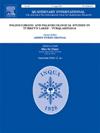Spatial variability of Holocene sediments in light studies of cores from the Arkona Basin, south-western Baltic Sea
IF 1.9
3区 地球科学
Q3 GEOGRAPHY, PHYSICAL
引用次数: 0
Abstract
Presented studies performed on two gravity cores with acoustic profiles, new radiocarbon dates from macrofossils, and results from previous studies, have outlined the spatial variability of Arkona Basin sediments. Analyses of diatoms, grain size, and geochemistry revealed characteristics of the depositional environment developed during the Ancylus and Littorina stages. New geochemical data, along with previous results from western Arkona Basin using the PCA method, revealed division sediments across three groups, explained by terrigenous silica, organic matter, and calcium content factors. The grain size distribution together with geochemical parameters confirmed the existence of the erosional brackish-water basement, visible in the acoustic profiles as the distinct reflector R3. Reflector R3 is located at the boundary between Ancylus Lake and Littorina Sea sediments and stands base of the initial Littorina Sea. Comparing grain size characteristics of the sediments deposited during the Littorina Sea stage revealed spatial diversity of the depositional environment in the Arkona Basin. The western cores located close to Darss Sill during the onset of the Littorina stage confirmed a calm depositional environment, while in the northern part of the basin, dynamic activity of bottom currents was observed. During the second phase of the Littorina stage, dated around 6 - 5 ka cal. BP, there was an intensification of sediment transport and deposition processes, accompanied by the appearance of marine diatom forms in the western cores. Simultaneously, relatively calm depositional conditions existed in the northern and central parts of the basin.
波罗的海西南部Arkona盆地全新世沉积物的空间变异特征
通过对两个重力岩心的声学剖面、宏观化石的新放射性碳测年以及先前研究的结果进行的研究,概述了Arkona盆地沉积物的空间变异性。通过对硅藻、粒度和地球化学的分析,揭示了安丘期和Littorina期沉积环境的特征。新的地球化学数据,以及先前使用PCA方法在Arkona盆地西部获得的结果,揭示了沉积物分为三组,由陆源二氧化硅、有机质和钙含量因素解释。粒度分布和地球化学参数证实了侵蚀微咸水基底的存在,在声波剖面上可以看到明显的反射面R3。R3反射器位于Ancylus湖和Littorina海沉积物的边界,位于最初的Littorina海的基地。对比滨海期沉积的沉积物粒度特征,揭示了Arkona盆地沉积环境的空间多样性。在Littorina期开始时,位于Darss Sill附近的西部岩心证实了一个平静的沉积环境,而在盆地北部,观察到底流的动力活动。在Littorina阶段的第二阶段(约6 ~ 5 ka cal. BP),沉积物的搬运和沉积过程加剧,同时在西部岩心出现了海洋硅藻。同时,盆地北部和中部存在相对平静的沉积条件。
本文章由计算机程序翻译,如有差异,请以英文原文为准。
求助全文
约1分钟内获得全文
求助全文
来源期刊

Quaternary International
地学-地球科学综合
CiteScore
5.60
自引率
4.50%
发文量
336
审稿时长
3 months
期刊介绍:
Quaternary International is the official journal of the International Union for Quaternary Research. The objectives are to publish a high quality scientific journal under the auspices of the premier Quaternary association that reflects the interdisciplinary nature of INQUA and records recent advances in Quaternary science that appeal to a wide audience.
This series will encompass all the full spectrum of the physical and natural sciences that are commonly employed in solving Quaternary problems. The policy is to publish peer refereed collected research papers from symposia, workshops and meetings sponsored by INQUA. In addition, other organizations may request publication of their collected works pertaining to the Quaternary.
 求助内容:
求助内容: 应助结果提醒方式:
应助结果提醒方式:


